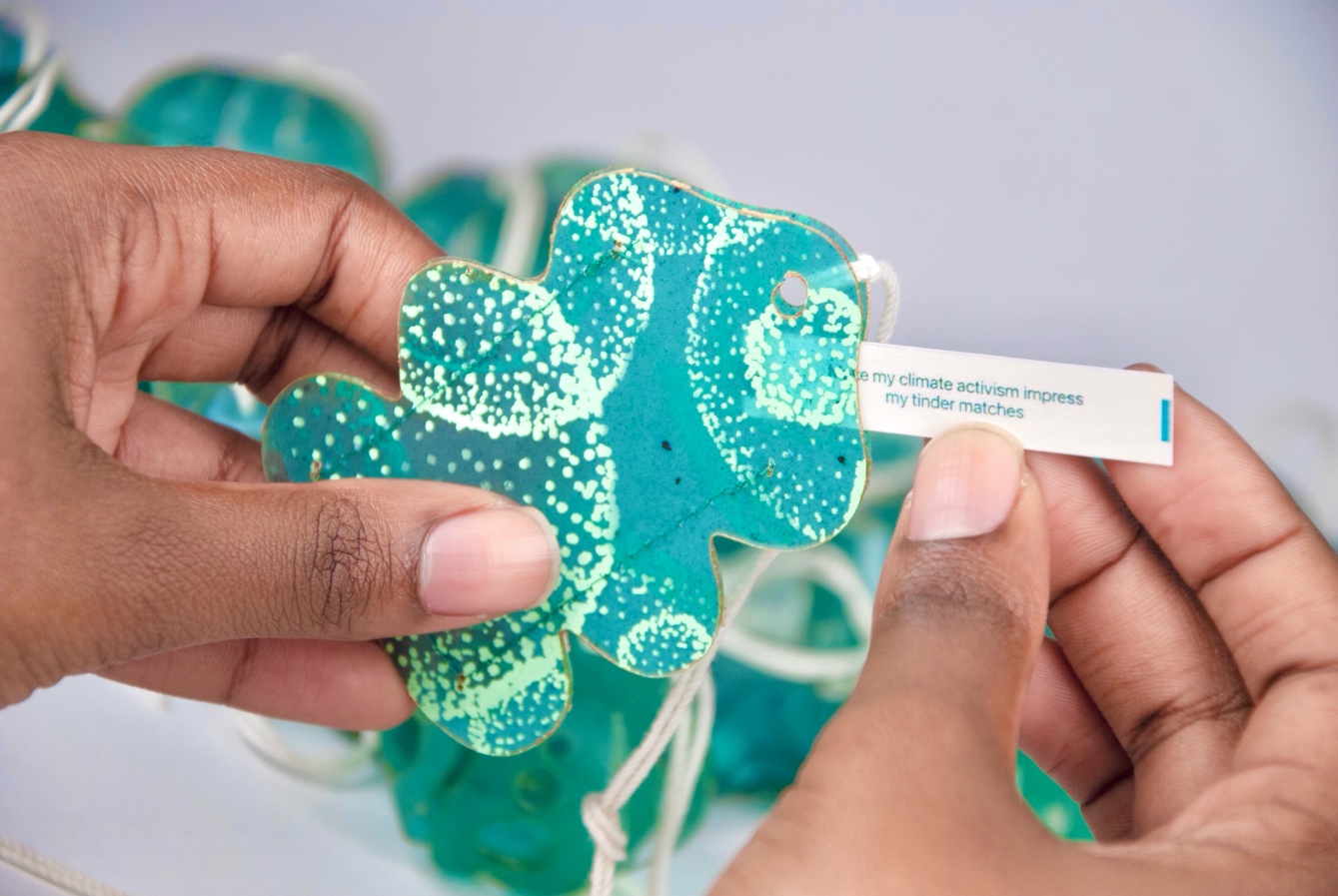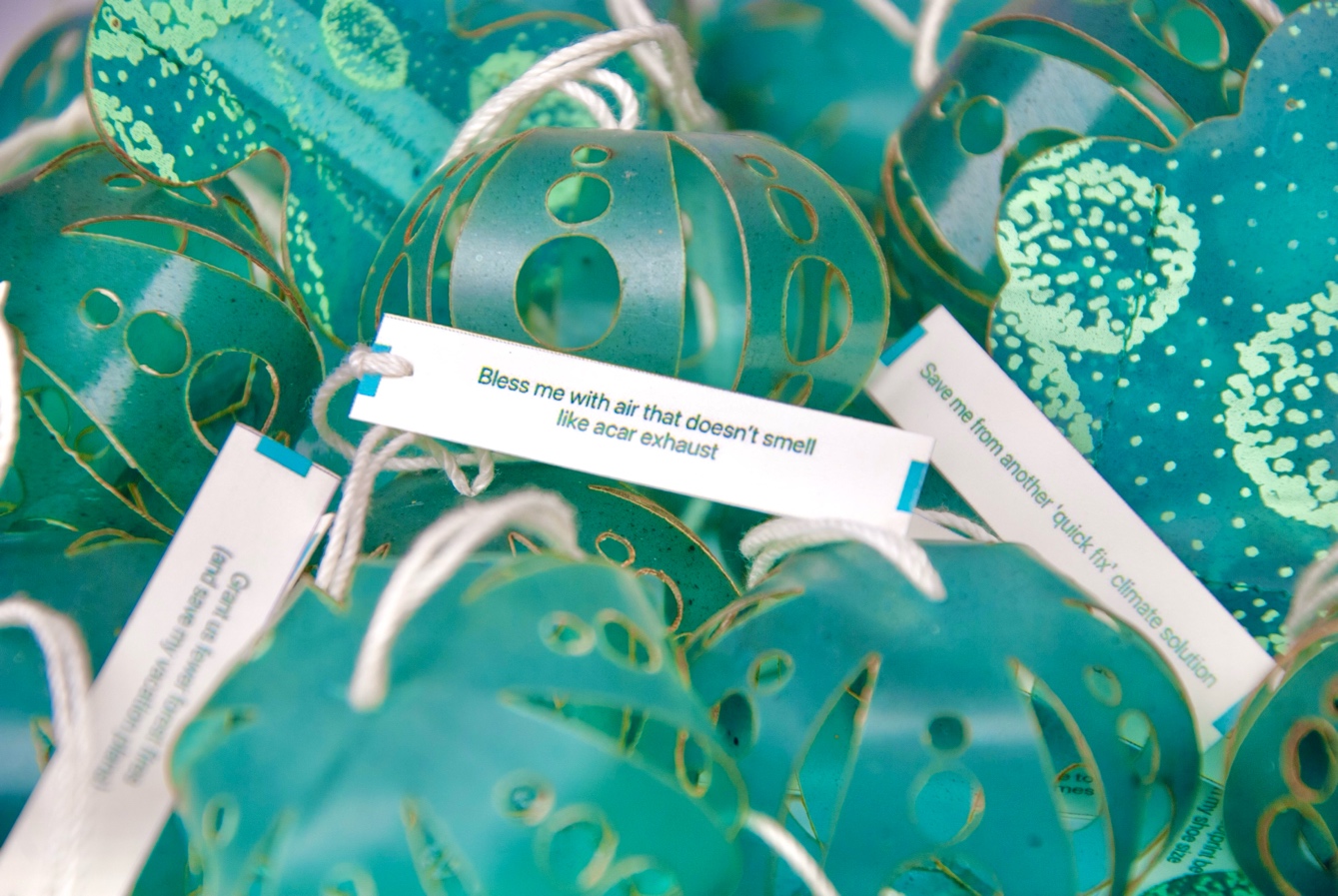Carbon Farm
DOI: https://doi.org/10.1145/3689050.3707686
TEI '25: Nineteenth International Conference on Tangible, Embedded, and Embodied Interaction, Bordeaux / Talence, France, March 2025
Contribute your CO₂ to our Carbon Farm, transforming it into nourishment for algae, which is then processed into bioplastics uniquely made from your breath. Speak or breathe into our CO₂ collector, choosing prompts like the Paris Climate Accord, corporate greenwashing, or a personal confession of your carbon footprint. Real-time feedback reveals your CO₂ emissions and their connection to algae growth, contextualizing your impact: how many breaths fuel your commute, your burger, or a flight?
Your exhaled CO₂ nurtures algae, which is harvested and converted into bioplastics. Take an amulet crafted from this material, imbued with climate-related wishes, and hang it on the Carbon Farm tree. By offering your breath, you join a circular carbon cycle where Carbon Farm strives to realize your climate wish.
Beyond its artistic value, Carbon Farm envisions household carbon sequestration, turning atmospheric CO₂ into filament for 3D printing and fostering sustainable bioproduction. While carbon removal (CDR) technologies like this are vital, they must complement large-scale emissions mitigation. For perspective, a year's worth of breaths into Carbon Farm offsets the carbon footprint of one cross-country flight, and 27,500 breaths are needed to offset a single burger.
ACM Reference Format:
Jiabao Li and Ben Evanson. 2025. Carbon Farm. In Nineteenth International Conference on Tangible, Embedded, and Embodied Interaction (TEI '25), March 04-07, 2025, Bordeaux / Talence, France. ACM, New York, NY, USA, 7 Pages. https://doi.org/10.1145/3689050.3707686
1 Introduction
The Carbon Farm device aims to raise awareness about carbon removal, its essential role in addressing climate change, and its limitations. By 2050, carbon removal may require 1% of the world's energy, 6% of arable land, and 3% of global water [1], yet it remains largely intangible to the public and could risk being misperceived as a substitute for direct emissions reduction. Research shows that public understanding of carbon impact is often inaccurate, especially regarding high-carbon foods like beef [2]. Carbon Farm addresses this by providing a tangible, embodied experience: participants exhale directly into the device, overcoming airflow resistance as algae growth visually represents captured CO₂, thus linking personal actions to broader environmental impacts. Existing studies highlight the importance of CDR awareness but lack direct, interactive experiences [6]. Carbon Farm fills this gap by physically engaging participants, deepening public understanding of carbon sequestration and its role in sustainable futures (Figure 1).

2 How it works
In the Carbon Farm, a fan pulls in ambient air, contacting the air with a chemical sorbent that reacts with the CO2 present at 400 parts per million in the air. This sorbent is suspended at the widest part of the hourglass shape which houses an electric resistive heater coil within it. During this first stage, air flows vertically through the metal hourglass system, coming out of the bottom with a lowered concentration of CO2. The second stage, desorption, involves activating the heater within the sorbent bed to release collected CO2 from the sorbent. This creates an air stream with a high concentration of CO2, which is then pumped into the 6 algae photobioreactors surrounding the metal hourglass, or contactor. In response to this heightened partial pressure of CO2, the algae increase their uptake rates, ultimately leading to a higher, more efficient rate of carbon sequestration per land area by the algae (Figure 2). Paramount in importance to this system, though, is what is done with the algae after it is grown; since left to rot, any CO2 fixed by the algae will be metabolized by microbes back into CO2. In such a case, the device will have achieved nothing in terms of carbon removal and instead have used an excessive amount of electrons to open valves, turn on fans, and make metal hot. As such, this system will utilize our harvested algae to create durable bioplastics, 3-D printable algae-based PLA, or algae-based garments, all showcased around the sculpture. We created the bioplastic sheath around the microphone, the beautiful hanging Hanfu garment (a fully wearable piece of clothing made from algae), screenprints of algae spirit, and other samples around the sculpture (Figure 3). All of them are biodegradable.


3 Interaction
While the Carbon Farm collects CO2 from the ambient atmosphere, individuals can also contribute their own higher concentration input stream of CO2. Participants are asked to take a bioplastic straw, insert it into the microphone, and then exhale their breath into the Carbon Farm. Using flow and CO2 concentration sensors, the device calculates the grams of CO2 provided by an individual, an estimate of that CO2’s conversion into algae biomass, and, last, a comparison of one's contribution to the emissions associated with the production of a hamburger. As an example of some average values, after blowing into the device, the LCD screen could read “CO2 contributed: 0.4 grams”, then “algae biomass produced: 0.2 grams”, and finally, “blowing 20,127 more times would offset one hamburger”. To note, the emissions associated with a hamburger are purely for a ¼ pound of beef, not including any other parts of the burger, the emissions associated with the restaurant, transportation, or anything else. The adsorption stage in normal DAC operation would transition to desorption once the sorbent had reached CO2 saturation; however, in this system, desorption is triggered by having five participants contribute their CO2. The number of participants who have gone (0, 1, 2, etc.) is tracked visually by different colors of the LED lights ringing the algae photobioreactors.
Carbon Farm transforms the hollow "hot air" of governmental and corporate climate statements into a tangible, grassroots ingredient for bioproduction. Participants' contributions nourish algae, which is harvested and converted into sustainable bioplastics. These bioplastics are crafted into amulets that carry climate-related wishes (Figure 4) (Figure 5). By hanging their amulets on the Carbon Farm tree, participants become part of a cycle, where their breath supports the realization of a collective climate vision. The climate wishes are funny and sarcastic. Humor is good way to get people out of the doom and gloom of climate fatigue so that they can take actions.


4 Exhibition-in-suitcases
At TEI, we will exhibit a novel, portable, and even wearable version of Carbon Farm: a compact unit that brings us one step closer to a grassroots, carbon-negative future. We see Carbon Farm as a device that connects people with living, circular ecosystems, creating a personal, symbiotic relationship between users and algae tailored to their unique biochemistry. This design not only enables participants to share their breath with algae, building a meaningful bond with the natural world, but also provides a tangible connection to the energy and emissions that shape our daily lives. Through this intimate interaction, Carbon Farm offers a personal, hands-on experience with sustainability, allowing users to engage directly in the cycles that power our modern world.
5 Conclusion
In Carbon Farm, we strive to achieve three primary goals: fostering public awareness of carbon sequestration, providing a tangible, embodied experience of personal carbon footprints, and cultivating a direct, symbiotic relationship between humans and non-human organisms. Through a device that uses our breath to nourish algae, participants not only gain a deeper understanding of their carbon impact but also experience a direct connection with the algae, an organism that plays a vital role in carbon capture. Additionally, this project explores the potential of algae-based biomaterials, promoting sustainable and accessible bio-innovation. By linking personal carbon contributions with the growth of living, carbon-sequestering organisms, Carbon Farm envisions a future where individuals actively participate in circular, regenerative ecosystems.
Acknowledgment
Lead engineer: Ben Evanson
Algae bioplastic design and fabrication: Siyu Fang, Ceren Ozgen, Maya Kotsovolos
Team: Aly Hirani, Miguel Esteva, Alan Hash, The UT Greenfund, Aidan Aalund, Tommy Brigham, Chas Cole, Brady Goar, Sophia Dai , Alex Gomez, Jacob Matthew, Kaylan Tchamdjou, Vishnu Nair, Julian Wearden, David Huo, Noah Lewis, Wulian Martinez, Vishrudh Sriramprasad, The UT DAC Team, Dr. Daniel Breecker, Dr. Michael Webber, Dr. Hugh Daigle, Dr. Schonna Manning, Dr. David Nobles, Dr. James Burrow.
References
- Fuhrman, J., McJeon, H., Patel, P., Doney, S. C., Shobe, W. M., & Clarens, A. F. 2023. The role of direct air capture and net-negative emissions in climate policy: An analysis of cost and energy demand. Nature Climate Change, 13, 4, 319-325. https://doi.org/10.1038/s41558-023-01604-9
- Camilleri, A. R., Larrick, R. P., Hossain, S., & Patino-Echeverri, D. 2019. Consumers underestimate the emissions associated with food but are aided by labels. Nature Climate Change, 9, 1, 53–58. https://doi.org/10.1038/s41558-018-0354-z
- Buck, H. J. 2016. Rapid scale-up of negative emissions technologies: Social barriers and social implications. Climatic Change, 139, 2, 155–167. https://doi.org/10.1007/s10584-016-1770-6
- Bellamy, R., & Raimi, K. T. 2023. Public perception and communication of carbon dioxide removal: A mitigation salience reduction hazard. Frontiers in Climate, 5, 1205388. https://doi.org/10.3389/fclim.2023.1205388
- Scott-Buechler, C., Dunlap, L., Leach, A., Turner, P., & Cross, J. 2023. The influence of educational interventions on public perceptions of direct air capture and carbon dioxide removal. Research Square. https://doi.org/10.21203/rs.3.rs-2658129/v1
- Sommer, L., Boykoff, M., Moser, S., O'Neill, S., & Weller, R. 2019. Creative (climate) communications: Productive pathways for science–policy exchange through art. Global Environmental Change, 59, 101992. https://doi.org/10.1016/j.gloenvcha.2019.101992
Permission to make digital or hard copies of part or all of this work for personal or classroom use is granted without fee provided that copies are not made or distributed for profit or commercial advantage and that copies bear this notice and the full citation on the first page. Copyrights for third-party components of this work must be honored. For all other uses, contact the owner/author(s).
TEI '25, March 04–07, 2025, Bordeaux / Talence, France
© 2025 Copyright held by the owner/author(s).
ACM ISBN 979-8-4007-1197-8/25/03.
DOI: https://doi.org/10.1145/3689050.3707686